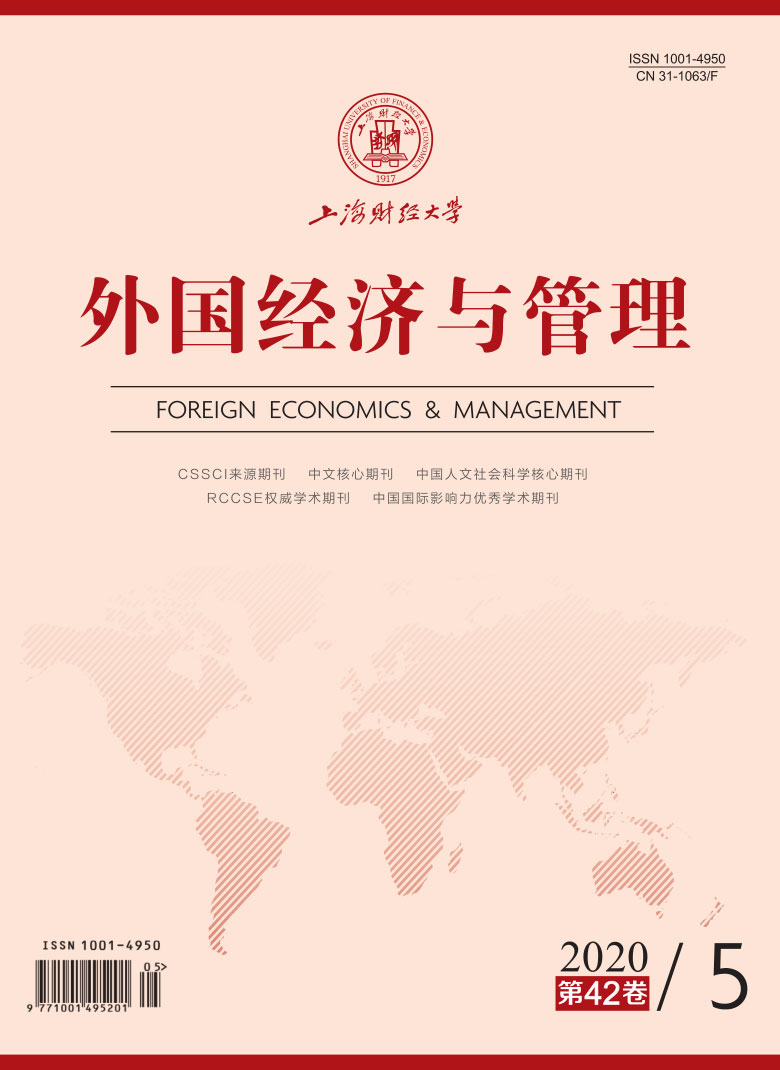现实中不少知名企业在遭遇危机时会聘任女性高管,出人意料的是相当数量的企业由此成功实现了反转,这一事实背后的逻辑引人深思。作为组织能力、战略选择与组织绩效间关系机理的底层逻辑,管理者认知是决定危机企业反转的重要因素。那么,女性高管是否在管理者认知方面具有独特性并在危机企业反转过程中起正向作用呢?本文选用沪深两市A股非金融类上市公司2005—2011年的数据,基于高阶梯队理论与管理者认知视角,构建了女性高管、专业能力与政治关联对危机企业反转的解释框架。在本研究的观测样本范围内,实证检验结果表明:(1)女性高管对危机企业反转呈现显著正向影响作用,高管中女性比例越高越有利于反转;且在排除行业特殊性和企业生命周期等因素的影响后,上述结论依旧成立。(2)专业能力、政治关联对女性高管与企业反转之间的关系起正向调节作用。本文反对附和“女性主义”来做“预设观点、政治正确”式研究,而是在高阶梯队理论和性别差异研究的进展之上,考虑“玻璃天花板”和“玻璃悬崖”效应,从管理者认知视角研究女性高管与危机企业反转的关系,为“雷曼姐妹假说”的验证做出了贡献,研究结论也为女性高管职位合法性提供了证据,对于企业通过高管团队建设稳定经营业绩具有启示意义。
“扶大厦之将倾”:女性高管、危机企业反转与管理者认知
摘要
参考文献
3 胡明霞, 干胜道. 生命周期效应、CEO权力与内部控制质量——基于家族上市公司的经验证据[J]. 会计研究,2018, (3): 64-70. DOI:10.3969/j.issn.1003-2886.2018.03.009
5 李兰, 仲为国, 王云峰. 中国女企业家发展: 现状、问题与期望——2505位女企业家问卷调查报告[J]. 管理世界,2017, (11): 50-64. DOI:10.3969/j.issn.1002-5502.2017.11.005
7 刘焱, 姚海鑫. 高管权力、审计委员会专业性与内部控制缺陷[J]. 南开管理评论,2014, (2): 4-12. DOI:10.3969/j.issn.1008-3448.2014.02.002
9 潘越, 戴亦一, 李财喜. 政治关联与财务困境公司的政府补助——来自中国ST公司的经验证据[J]. 南开管理评论,2009, (5): 6-17. DOI:10.3969/j.issn.1008-3448.2009.05.003
11 任颋, 王峥. 女性参与高管团队对企业绩效的影响: 基于中国民营企业的实证研究[J]. 南开管理评论,2010, (5): 81-91. DOI:10.3969/j.issn.1008-3448.2010.05.011
12 谭燕, 蒋华林, 吴静, 等. 企业生命周期、财务资助与银行贷款——基于A股民营上市公司的经验证据[J]. 会计研究,2018, (5): 36-43. DOI:10.3969/j.issn.1003-2886.2018.05.005
13 徐高彦, 曹俊颖, 陶颜, 等. 高管—员工薪酬差距、资产紧缩策略与危机企业反转[J]. 会计研究,2018, (10): 58-65. DOI:10.3969/j.issn.1003-2886.2018.10.008
14 周泽将, 徐硕, 马静. 政治关联、事务所背景与盈余管理——基于独立董事视角的经验证据[J]. 审计研究,2017, (6): 99-104, 112. DOI:10.3969/j.issn.1002-4239.2017.06.014
15 Abdellaoui M, Bleichrodt H, Paraschiv C. Loss aversion under prospect theory: A parameter-free measurement[J]. Management Science,2007, 53(10): 1659-1674. DOI:10.1287/mnsc.1070.0711
16 Abebe M A, Tangpong C. Founder-CEOs and corporate turnaround among declining firms[J]. Corporate Governance,2018, 26(1): 45-57. DOI:10.1111/corg.12216
17 APA. APA dictionary of psychology[EB/OL]. https://dictionary.apa.org/, 2019.
18 Argote L, Greve H R. A behavioral theory of the firm—40 years and counting: Introduction and impact[J]. Organization Science,2007, 18(3): 337-349. DOI:10.1287/orsc.1070.0280
19 Bao G M, Liao Z J, Hine D. Managerial cognition, emergency preparedness and firm’s emergency response performance[J]. Journal of Risk Research,2019, 22(12): 1490-1502. DOI:10.1080/13669877.2018.1485171
20 Barbero J L, Di Pietro F, Chiang C. A rush of blood to the head: Temporal dimensions of retrenchment, environment and turnaround performance[J]. Long Range Planning,2017, 50(6): 862-879. DOI:10.1016/j.lrp.2017.02.004
22 Bruckmüller S, Branscombe N R. The glass cliff: When and why women are selected as leaders in crisis contexts[J]. British Journal of Social Psychology,2010, 49(3): 433-451. DOI:10.1348/014466609X466594
23 Bundy J, Pfarrer M D. A burden of responsibility: The role of social approval at the onset of a crisis[J]. Academy of Management Review,2015, 40(3): 345-369. DOI:10.5465/amr.2013.0027
24 Bundy J, Pfarrer M D, Short C E, et al. Crises and crisis management: Integration, interpretation, and research development[J]. Journal of Management,2017, 43(6): 1661-1692. DOI:10.1177/0149206316680030
25 Bundy J, Vogel R M, Zachary M A. Organization-stakeholder fit: A dynamic theory of cooperation, compromise, and conflict between an organization and its stakeholders[J]. Strategic Management Journal,2018, 39(2): 476-501. DOI:10.1002/smj.2736
26 Carpenter M A, Geletkanycz M A, Sanders W G. Upper echelons research revisited: Antecedents, elements, and consequences of top management team composition[J]. Journal of Management,2004, 30(6): 749-778. DOI:10.1016/j.jm.2004.06.001
27 Chen G L. Initial compensation of new CEOs hired in turnaround situations[J]. Strategic Management Journal,2015, 36(12): 1895-1917. DOI:10.1002/smj.2321
28 Cook A, Glass C. Above the glass ceiling: When are women and racial/ethnic minorities promoted to CEO?[J]. Strategic Management Journal,2014, 35(7): 1080-1089. DOI:10.1002/smj.2161
29 Cumming D, Leung T Y, Rui O. Gender diversity and securities fraud[J]. Academy of Management Journal,2015, 58(5): 1572-1593. DOI:10.5465/amj.2013.0750
30 Dickinson V. Cash flow patterns as a proxy for firm life cycle[J]. The Accounting Review,2011, 86(6): 1969-1994. DOI:10.2308/accr-10130
31 Eggers J P, Kaplan S. Cognition and capabilities: A multi-level perspective[J]. Academy of Management Annals,2013, 7(1): 295-340. DOI:10.5465/19416520.2013.769318
32 Faccio M, Marchica M T, Mura R. CEO gender, corporate risk-taking, and the efficiency of capital allocation[J]. Journal of Corporate Finance,2016, 39: 193-209. DOI:10.1016/j.jcorpfin.2016.02.008
33 Gazzaniga M, Heatherton T, Halpern D. Psychological science[M]. 3rd ed. New York: Norton, 2010.
34 Glass C, Cook A. Leading at the top: Understanding women’s challenges above the glass ceiling[J]. The Leadership Quarterly,2016, 27(1): 51-63. DOI:10.1016/j.leaqua.2015.09.003
35 Helfat C E, Peteraf M A. Managerial cognitive capabilities and the microfoundations of dynamic capabilities[J]. Strategic Management Journal,2015, 36(6): 831-850. DOI:10.1002/smj.2247
36 Kaplan S. Research in cognition and strategy: Reflections on two decades of progress and a look to the future[J]. Journal of Management Studies,2011, 48(3): 665-695. DOI:10.1111/j.1467-6486.2010.00983.x
37 McKinley W, Latham S, Braun M. Organizational decline and innovation: Turnarounds and downward spirals[J]. Academy of Management Review,2014, 39(1): 88-110. DOI:10.5465/amr.2011.0356
38 Musteen M, Liang X, Barker Ⅲ V L. Personality, perceptions and retrenchment decisions of managers in response to decline: Evidence from a decision-making study[J]. The Leadership Quarterly,2011, 22(5): 926-941. DOI:10.1016/j.leaqua.2011.07.012
39 Nadkarni S, Barr P S. Environmental context, managerial cognition, and strategic action: An integrated view[J]. Strategic Management Journal,2008, 29(13): 1395-1427. DOI:10.1002/smj.717
40 Ndofor H A, Sirmon D G, He X M. Utilizing the firm’s resources: How TMT heterogeneity and resulting faultlines affect TMT tasks[J]. Strategic Management Journal,2015, 36(11): 1656-1674. DOI:10.1002/smj.2304
41 Ndofor H A, Vanevenhoven J, Barker Ⅲ V L. Software firm turnarounds in the 1990s: An analysis of reversing decline in a growing, dynamic industry[J]. Strategic Management Journal,2013, 34(9): 1123-1133. DOI:10.1002/smj.2050
42 Ryan M K, Haslam S A, Morgenroth T, et al. Getting on top of the glass cliff: Reviewing a decade of evidence, explanations, and impact[J]. The Leadership Quarterly,2016, 27(3): 446-455. DOI:10.1016/j.leaqua.2015.10.008
44 Sent E M, Van Staveren I. A feminist review of behavioral economic research on gender differences[J]. Feminist Economics,2019, 25(2): 1-35. DOI:10.1080/13545701.2018.1532595
45 Sheng S B, Zhou K Z, Li J J. The effects of business and political ties on firm performance: Evidence from China[J]. Journal of Marketing,2011, 75(1): 1-15. DOI:10.1509/jm.75.1.1
46 Tangpong C, Abebe M, Li Z H. A temporal approach to retrenchment and successful turnaround in declining firms[J]. Journal of Management Studies,2015, 52(5): 647-677. DOI:10.1111/joms.12131
47 Trahms C A, Ndofor H A, Sirmon D G. Organizational decline and turnaround: A review and agenda for future research[J]. Journal of Management,2013, 39(5): 1277-1307. DOI:10.1177/0149206312471390
48 Van Staveren I. The Lehman sisters hypothesis[J]. Cambridge Journal of Economics,2014, 38(5): 995-1014. DOI:10.1093/cje/beu010
49 Vial A C, Napier J L, Brescoll V L. A bed of thorns: Female leaders and the self-reinforcing cycle of illegitimacy[J]. The Leadership Quarterly,2016, 27(3): 400-414. DOI:10.1016/j.leaqua.2015.12.004
50 Williams T A, Gruber D A, Sutcliffe K M, et al. Organizational response to adversity: Fusing crisis management and resilience research streams[J]. Academy of Management Annals,2017, 11(2): 733-769. DOI:10.5465/annals.2015.0134
引用本文
徐高彦, 李桂芳, 陶颜, 等. “扶大厦之将倾”:女性高管、危机企业反转与管理者认知[J]. 外国经济与管理, 2020, 42(5): 42-59.
导出参考文献,格式为:
上一篇:品牌架构战略研究回顾与展望






 6441
6441  14273
14273

